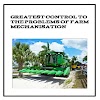Weeds compete with planted crops with space, light , nutrients etc.
All farmers needs a lot of work to prevent their crops from being invaded by weeds. Losses in crop yield due to weeds may be greater that those due to pest and diseases. If a farmers definitely fails to control weeds growth, the chances of successful crop production are seriously reduced.
Effects of Weeds
The harm done by weeds is mainly their competition with crops.The effects of weeds on crops includes:
1. Weeds compete with crops for spaces: Weeds develops rapidly than that of planted crops and the space needed for health growth plants will be reduced.
2. Weeds compete with crops for sunlight: Weeds are capable of producing many larges leaves with shades crops and reduces the sunlight that is needed for planted crops needed for photosynthesis.
3. Weeds compete with plants for nutrients: The roots of weeds rapidly develops and it's considerably of removing the nutrients proportion for planted crops and thereby reducing the growth of crops.
4. Loss in crop yield: The competition between crops and weeds will eventually result in low yield of crops.
5. Loss in incomes of farmers: The low yield coupled with the reduction in the quality of produce and the no control of weeds will lead to loss for the farmers.
6. Weeds habour pests and diseases: Some weeds may be a home for some diseases and pest by acting as a host and it will provides insect that will eat the farm product.
7. Reduction is palatability of some grasses: Weeds do invades pastures , reducing the palatability of useful grasses that can be used for hay to feed animals.
8. Some weeds are toxic to farm animals: The leaves of some weeds contains toxins which may damage the body of farm animals.
Reason for Controlling Weeds
1. Weeds causes losses in crop yields
2. Weeds leads to increased cost of farm operation , thereby leading to inefficiency of farm operations
3. Poisonous weeds are dangerous to man.
4. Weeds reduces land value.
5. Reduces the quality of crop product.
6. It form an alternative host for pest.
7. Weeds increases cost of harvesting.
Usefulness of Weeds
1. Some weeds serves as cover crops.
2. Some weeds can help to control erosion
3. Some uninfected weeds can be used for compost manure.
4. Some weeds are used to feed animals.
Characteristics and Growth Habits in Weeds
Weeds often posses characteristics which increases their growth habits and mode of dispersal. Factors that aids the growth habits includes:
1. Production of Large Quantity Seed: Most weeds always produces a large quantity of seeds which germinate and grow fast.
2. Most weeds aee wind pollinated: Weeds can be transferred by winds fromone place to another and enhances it spread without any hindrance.
3. Rapid Growth of leaves : Rapidly growing weeds may produce many relatively large leaves within a very short time.They may cause shades and compete with crops for sunlight of they are not properly controlled early.
4. Weed Grows in the Rainy Season: Most weeds are favoured during raining season as they germinate faster during raining season as water will be sufficiently available.
5. Some weeds reproduces through Vegetative Propagation: Most perennial weed are reproduced through Vegetative Propagation as they would be with some agents like rhizomes or stolons which spreads rapidly.
Dispersal of Weeds
Most seeds and fruits of weeds are dispersed generally by winds and animals.Mode of dispersal includes:
1. Dispersal of seed by wind: The seeds of some weeds are specially reproduced through the dispersal by winds.Weed seeds which spreads by their seeds through the agent of wind includes: goat weed, tridax procumbent, guinea grass, elephant garss, and many others
2. Dispersal of seed by animals: Animals like man , antelopes , rats, rabbits etc are involved in the dispersal of weed seeds. Examples of weeds that are dispersed by man includes pig weeds, commelina Spp etc
3. Dispersal of seed by water: Water can disperse weeds through some water channels like riverine areas. Seeds of such weeds will be light in weight, waterproof etc.
4. Dispersion of seed by explosive mechanism: A few plants and all leguminous weeds are dispersed by explosive mechanism.Examples of weeds that are dispersed by this are: talinum triangulae, centrosema, mucuna, calopogium etc.
Common Weeds Found in Farms and Botanical Name
Commons weeds found in farm includes1. Guinea grass- Botanical name of Panicum maximum.
2. Bahama grass of botanical name of Cynodum dactylon.
3. Carpet grass of botanical name of Axonopus compresses
4. Centro has a botanical name of Centrosema pubesen
5. Tridax grass has a botanical name of Tridax procumbens.
6. Wire grass of botanical name of Aspilia africana.
7. Stubborn weeds has a botanical name of Sida acuta
8. Stylo has a botanical name of Stylosanthes grails
9. Water leaf has a botanical name of Talinum triangulae.
10. Goat Weds has a botanical name of Ageratum conizoids.
11. Pig weed has a botanical name of Boerhavia diffusa.
12. Calopo has a botanical name of Calopogium mucunoides.
13. Bush green has botanical of Amaranthus spinosus.
14. Elephant grass has botanical name of Penisetum purpureum.
15. Sensitive plants has a botanical name of Mimosa pundia
General Controls of Weeds
Weeds can be controlled through a number of methods.These includes:1. Mechanical /Physical Control: The mechanical control includes
(a) Hand picking: This involves the uprooting of weeds with hand from the soil.It is the most effective control.
(b) Hoeing: This is uprooting of weeds with hoe before and after planting.
(c) Rotatory Cultivation: This is the using of hand drawn implements to undertake the ploughing and burying of weeds.
2. Biological Controls: This is the introduction of some insect and herbivorous animals to eat up the leaves.
3. Cultural Controls: This involses the practice of crop rotation and growth of cover crops.The cultural methods includes:
(a) Flooding
(b) Burning
(c) Mulching
(d) Cover Cropping
(e) Crop Rotation
4. Chemical Controls: This involves the use of chemical solutions called herbicides to control the growth of weeds.
(c) Rotatory Cultivation: This is the using of hand drawn implements to undertake the ploughing and burying of weeds.
2. Biological Controls: This is the introduction of some insect and herbivorous animals to eat up the leaves.
3. Cultural Controls: This involses the practice of crop rotation and growth of cover crops.The cultural methods includes:
(a) Flooding
(b) Burning
(c) Mulching
(d) Cover Cropping
(e) Crop Rotation
4. Chemical Controls: This involves the use of chemical solutions called herbicides to control the growth of weeds.







0 Comments